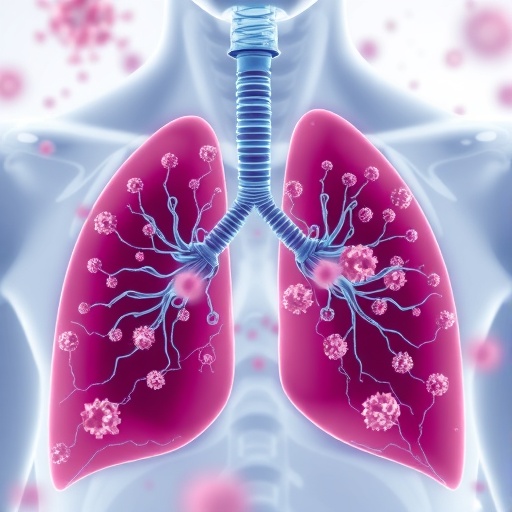The advent of immunotherapy has revolutionized the treatment landscape for lung cancer, offering new hope to patients through harnessing the body’s own immune system to combat tumor cells. However, this evolving frontier carries complexities, especially when patients concurrently suffer from infections. A groundbreaking study recently published in BMC Cancer uncovers how next-generation sequencing technologies can illuminate the intricate interplay between lung cancer immunotherapy and infection dynamics, promising improvements in diagnostic precision and patient management.
In a comprehensive clinical investigation spanning December 2022 to July 2025, researchers at Jingzhou First People’s Hospital enrolled 107 lung cancer patients burdened with infections. These patients were categorized into two cohorts: one receiving immunotherapy and the other not. By utilizing electronic bronchoscopy combined with metagenomic next-generation sequencing (mNGS), the team meticulously characterized pathogen presence alongside clinical and laboratory parameters, revealing notable differences in infection profiles influenced by immunotherapy.
The study’s results underscore a higher incidence of fever among immunotherapy recipients, a clinical sign reflective of heightened immune activation or possibly inflammatory complications. Correspondingly, hospital stays and associated healthcare expenditures were more prolonged and costly in this group, indicating that immunotherapy may impose additional clinical management challenges when compounded by infections.
Laboratory analyses further delineated the biological milieu accompanying immunotherapy. Patients demonstrated elevated levels of D-dimer—a marker linked to coagulation—and inflammatory markers including C-reactive protein (CRP), procalcitonin (PCT), and interleukin-6 (IL-6). Conversely, reductions in albumin and hemoglobin levels suggested a systemic inflammatory response, compromised nutritional status, or bone marrow involvement, emphasizing the multi-dimensional impact of immunotherapy combined with infection.
Delving deeply into pathogen characterization, the study highlights a significant rise in pure bacterial infections among the immunotherapy group, with Mycobacterium tuberculosis notably prevalent. This finding is pivotal given tuberculosis’ propensity for reactivation in immunocompromised states, implying that immune checkpoint modulation heightens vulnerability to specific bacterial pathogens.
Intriguingly, mixed infections involving fungi were also disproportionately represented post-immunotherapy. Pneumocystis jirovecii and Aspergillus terreus emerged as predominant fungal agents in this setting. These opportunistic pathogens are notorious for causing severe pulmonary complications in immunosuppressed hosts, raising concerns about vigilant monitoring and preemptive antifungal strategies during immunotherapy courses.
Contrastingly, the non-immunotherapy cohort displayed a higher frequency of mixed bacterial infections, with Pseudomonas aeruginosa and Haemophilus influenzae as the chief culprits. These organisms tend to thrive in chronic lung disease and hospital environments, indicating differing ecological niches and immune interactions based on treatment modalities.
Viral infections presented their own patterns. Epstein-Barr virus (EBV) predominated in the immunotherapy group, while the non-immunotherapy group witnessed additional viral pathogens such as influenza A virus H1N1. This distribution may reflect immune modulation effects on viral latency and reactivation, underscoring complex host-virus dynamics intertwined with cancer treatment regimens.
One of the study’s landmark contributions is validating the utility of mNGS as a diagnostic powerhouse in this complex clinical context. Unlike conventional microbial detection techniques that rely on targeted assays and have longer turnaround times, mNGS provides unbiased, comprehensive pathogen identification at unprecedented speed and sensitivity. This capability not only accelerates diagnosis but also informs tailored antimicrobial therapies, potentially improving clinical outcomes.
Furthermore, the study’s revelations urge oncologists and infectious disease specialists to adopt integrated management approaches for lung cancer patients undergoing immunotherapy. Routine screening for tuberculosis and fungal pathogens such as Pneumocystis jirovecii should be considered, alongside vigilant monitoring of inflammatory markers to anticipate and mitigate infectious complications.
In addition to diagnostics, these findings have therapeutic implications. Prophylactic strategies against specific infections in high-risk patients might minimize morbidity. Adjustments in immunotherapy dosing or scheduling could be explored to balance anti-tumor efficacy with infection susceptibility, paving the way for precision medicine paradigms.
Moreover, the study highlights the complexity of interpreting inflammatory markers in patients under immunotherapy, where immune activation by treatment and infection-induced inflammation can overlap. Physicians must therefore contextualize laboratory results within comprehensive clinical assessments to guide appropriate interventions without undue therapeutic delays.
Another dimension to consider is the economic and resource allocation impact. With longer hospital stays and elevated costs associated with immunotherapy and concurrent infections, healthcare systems must anticipate increased burdens. Early and accurate infection detection via mNGS might offset some costs by preventing complications and reducing empirical broad-spectrum antimicrobial use.
From a research perspective, these insights open avenues for further exploration of immune-pathogen interactions in the oncologic setting. Understanding how immune checkpoint inhibitors influence host defenses against various microorganisms could inform vaccine development, infection prevention protocols, and novel immunomodulatory therapies.
In conclusion, this seminal study elucidates how second-generation sequencing technologies, specifically mNGS, provide crucial diagnostic and clinical insights into the infectious complications accompanying lung cancer immunotherapy. By revealing distinct infection patterns, pathogen distributions, and immune response dynamics, it sets a new standard for managing this vulnerable patient population. The integration of advanced molecular diagnostics with multidisciplinary clinical care promises to optimize therapeutic outcomes and enhance quality of life for patients facing the dual challenges of cancer and infection.
As lung cancer immunotherapy continues to advance, integrating next-generation sequencing into routine practice will be indispensable. This study not only substantiates mNGS’s diagnostic value but also catalyzes a transformative approach to personalize infection surveillance and treatment strategies in oncology, heralding a new era of precision medicine where immune modulation and microbial diagnostics converge for superior patient care.
Subject of Research: The clinical impact and diagnostic utility of second-generation gene sequencing (mNGS) in detecting infections in lung cancer patients undergoing immunotherapy.
Article Title: The value of second-generation gene sequencing in lung cancer immunotherapy with concurrent infections.
Article References: Zhang, Y., Zhang, Q., Wang, L. et al. The value of second-generation gene sequencing in lung cancer immunotherapy with concurrent infections. BMC Cancer 25, 1636 (2025). https://doi.org/10.1186/s12885-025-15045-4
Image Credits: Scienmag.com
DOI: https://doi.org/10.1186/s12885-025-15045-4
Keywords: Lung cancer, immunotherapy, infection, metagenomic next-generation sequencing, mNGS, tuberculosis, Pneumocystis jirovecii, Aspergillus terreus, Epstein-Barr virus, diagnostics, immune checkpoint inhibitors
Tags: clinical management of lung cancerdiagnostic precision in cancer immunotherapyfever as a clinical sign in cancer therapyhealthcare costs associated with immunotherapyimmunotherapy complications in patientsinfection dynamics in lung cancerlung cancer immunotherapylung cancer patient cohort studiesmetagenomic sequencing applicationsnext-generation sequencing in oncologypathogen characterization in cancer treatmentsecond-generation sequencing technologies





